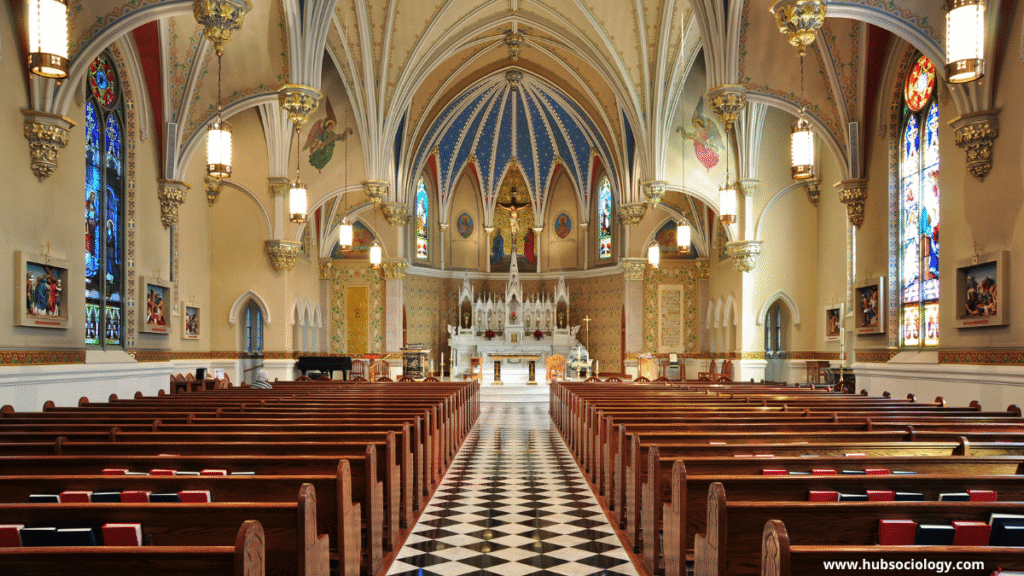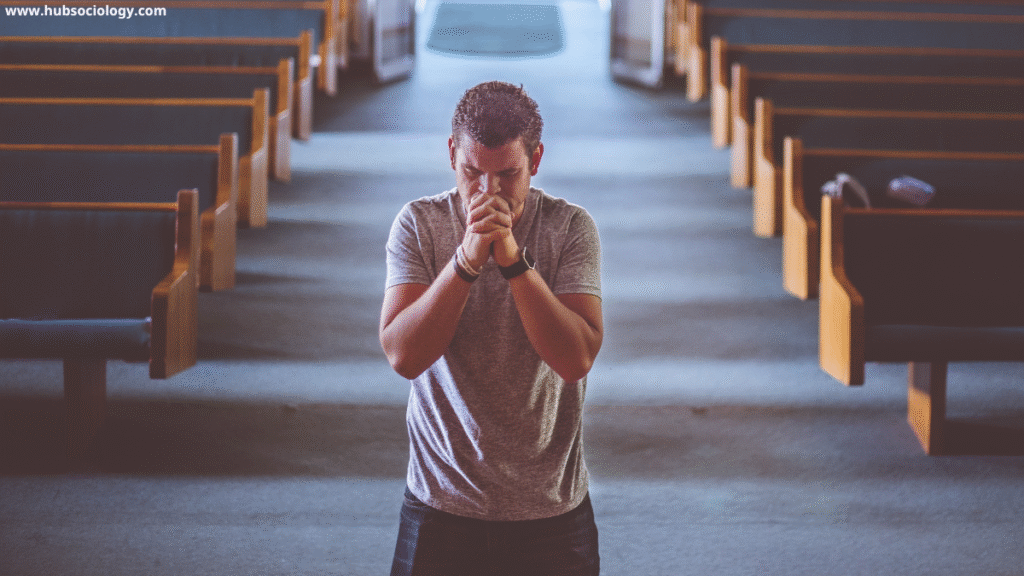Religion has always been a significant institution in society, shaping culture, morality, and social behavior. Sociologists study religion not just as a set of beliefs but as a social institution that influences and is influenced by economic, political, and cultural forces. To better understand religious organizations, scholars have classified them into different types: church, sect, denomination, and cult. Each of these forms represents different ways in which religion is organized, practiced, and experienced in society. This typology, introduced and refined by sociologists such as Max Weber, Ernst Troeltsch, and later Bryan Wilson, helps us analyze the diverse expressions of religiosity across history and cultures.

Church: Institutionalized and Universal Religion
The church is seen as a large, institutionalized, and bureaucratically organized form of religion that seeks to encompass all of society. It has formal rituals, doctrines, and hierarchies, and often enjoys a close relationship with the state. Churches usually emphasize tradition, authority, and social order.
Features of a Church
- Universal Orientation – Churches generally aim to include the entire population within their religious framework. For instance, in medieval Europe, the Catholic Church functioned as a universal religious authority.
- Formal Organization – Churches are hierarchical, with professional clergy, structured rituals, and codified doctrines.
- Integration with Society – Churches often align themselves with political and economic institutions, reinforcing social norms and stability.
- Conservatism – Churches tend to be traditionalist, resisting radical change, and focusing on maintaining moral and social order.
Sociological Role
The church functions as an agent of social cohesion and legitimization of authority. By offering a moral framework, it stabilizes society, but it may also reinforce existing power hierarchies. Durkheim emphasized that the church is a collective representation of society’s shared values, binding people together in a moral community.
Sect: A Protest Against the Church
In contrast to the church, a sect arises as a protest movement, often formed by groups dissatisfied with established religious institutions. Sects are smaller, more voluntary, and emphasize personal commitment, purity, and strict moral codes.
Features of a Sect
- Voluntary Membership – Unlike churches that include large populations, sects recruit committed members who consciously choose to join.
- Opposition to the Establishment – Sects often challenge the authority, rituals, or doctrines of mainstream churches.
- Strict Discipline – Members are expected to follow rigorous moral codes and maintain high levels of participation.
- Charismatic Leadership – Sects frequently emerge around a leader who inspires followers with new interpretations of faith.
Examples and Role
Historically, Protestant movements such as the Puritans began as sects in opposition to the Catholic Church. In modern times, groups like the Jehovah’s Witnesses or the Amish retain sect-like characteristics. Sects can act as agents of change, revitalizing religious practices and challenging the dominance of mainstream churches. However, they may also create exclusivity and conflict with broader society.
Denomination: A Middle Ground
The denomination occupies a middle position between the institutionalized church and the protest-oriented sect. It is a stable, recognized, and relatively tolerant religious organization that coexists with other religious groups in a pluralistic society. Denominations are more flexible than churches but more institutionalized than sects.
Features of a Denomination
- Pluralism and Tolerance – Denominations recognize the legitimacy of other religious groups, unlike churches that often claim exclusivity.
- Bureaucratic Organization – Denominations have formal structures but are not as rigid or centralized as churches.
- Balance of Tradition and Flexibility – They retain rituals and traditions while allowing some adaptation to social change.
- Membership – Belonging to a denomination is usually based on voluntary association rather than universal inclusion.
Examples and Role
The Baptists, Methodists, and Lutherans in the United States are denominations. They do not claim to represent the whole of society but instead operate within a framework of religious pluralism. Denominations contribute to religious diversity, providing individuals with choices while promoting social integration in multi-religious societies.
Cult: Innovation and New Religious Movements
The cult represents the most unconventional form of religious organization. Cults are often innovative, centered around new revelations, spiritual experiences, or charismatic leaders. Unlike sects, which emerge as reformist movements within established traditions, cults frequently introduce entirely new religious ideas or blend elements from various traditions.

Features of a Cult
- Novelty and Innovation – Cults often introduce new doctrines, spiritual practices, or reinterpret existing traditions in radical ways.
- Charismatic Leadership – Cults are frequently led by a central figure who claims unique spiritual authority or divine revelation.
- Small and Exclusive – Membership is typically small, voluntary, and intensely committed.
- High Tension with Society – Cults are often seen as deviant by mainstream society and may face hostility or suspicion.
Examples and Role
Examples include the Hare Krishna movement, Scientology, or groups like the Unification Church. Cults may also evolve over time into sects or denominations if they gain stability and broader acceptance. Sociologically, cults represent religious innovation and reflect the search for meaning in times of social uncertainty.
Comparative Analysis
To better understand these categories, it is helpful to compare them along sociological dimensions:
| Feature | Church | Sect | Denomination | Cult |
|---|---|---|---|---|
| Size | Large, universal | Small, exclusive | Medium, voluntary | Small, exclusive |
| Membership | Ascribed (by birth) | Voluntary, selective | Voluntary, inclusive | Voluntary, selective |
| Relation to Society | Supportive of status quo | Critical, oppositional | Tolerant, pluralistic | In tension with society |
| Organization | Hierarchical, bureaucratic | Informal, leader-centered | Formal but flexible | Charismatic leadership |
| Examples | Catholic Church | Amish, Jehovah’s Witnesses | Methodists, Baptists | Scientology, Hare Krishna |
This typology shows how religion adapts and evolves. Churches emphasize social order, sects stress purity and reform, denominations promote pluralism, and cults embody innovation and experimentation.
Sociological Interpretations
- Durkheim – Saw religion (especially church) as a representation of society itself, uniting people in collective moral life.
- Weber – Emphasized the role of charismatic authority, especially in sects and cults, where leaders inspire followers through personal magnetism.
- Troeltsch – Distinguished between church and sect, highlighting how sects arise in protest against rigid institutions.
- Bryan Wilson – Extended the typology by analyzing how religious movements (sects and cults) respond to modernity, secularization, and social change.
Contemporary Relevance
In today’s globalized world, these categories help us understand religious pluralism and transformation:
- Churches (like the Catholic or Orthodox Churches) remain influential in shaping moral discourse.
- Sects continue to challenge mainstream values, emphasizing alternative lifestyles.
- Denominations thrive in societies with religious freedom, reflecting diversity without conflict.
- Cults and New Religious Movements reveal how individuals seek meaning outside traditional frameworks, often responding to modern crises such as alienation, consumerism, and identity struggles.
Conclusion

The concepts of church, sect, denomination, and cult provide sociologists with valuable tools to classify and analyze religious organizations. Each form represents a different balance between tradition and change, inclusion and exclusivity, conformity and innovation. Churches preserve social order, sects inspire reform, denominations sustain diversity, and cults innovate spiritual meaning. Together, they illustrate the dynamic and evolving nature of religion in human society. Understanding these distinctions not only deepens our knowledge of religious life but also highlights the ways in which religion continues to influence culture, identity, and social transformation in the modern world.
Do you like this this Article ? You Can follow as on :-
Facebook – https://www.facebook.com/hubsociology
Whatsapp Channel – https://whatsapp.com/channel/0029Vb6D8vGKWEKpJpu5QP0O
Gmail – hubsociology@gmail.com
Topic-related questions
5 Marks Questions
- Define the concept of a church in sociology.
- State two key differences between a sect and a denomination.
- What is meant by a cult in sociological studies?
- Give two examples of denominations in Christianity.
- Who introduced the church–sect typology in sociology?
10 Marks Questions
- Explain the main characteristics of a sect with suitable examples.
- Discuss the sociological significance of the church as an institution.
- Differentiate between denomination and cult in terms of organization and social orientation.
- How do cults reflect religious innovation and respond to modern social changes?
- Examine Max Weber’s view on charismatic authority in relation to sects and cults.
15 Marks Questions
- Compare and contrast church, sect, denomination, and cult with examples.
- Analyze the role of denominations in promoting religious pluralism in modern societies.
- Discuss the typology of religious organizations (church, sect, denomination, cult) with reference to the works of Troeltsch, Weber, and Bryan Wilson.
- Evaluate the relevance of the church–sect–cult–denomination framework in understanding contemporary religious movements.
- “Churches preserve social order, sects inspire reform, denominations promote diversity, and cults innovate meaning.” Critically examine this statement from a sociological perspective.
